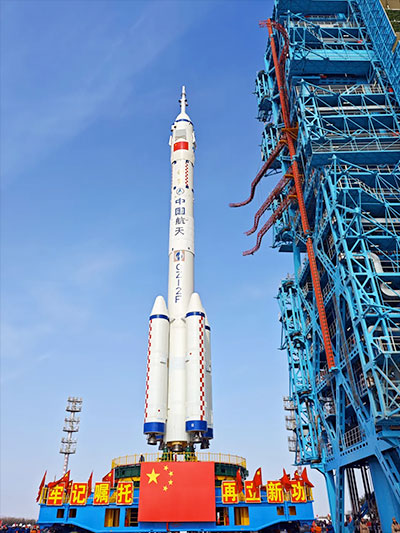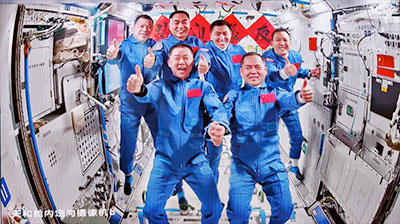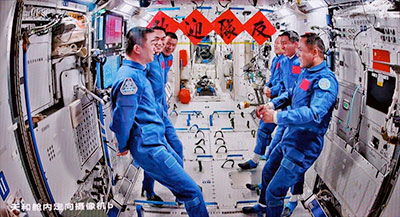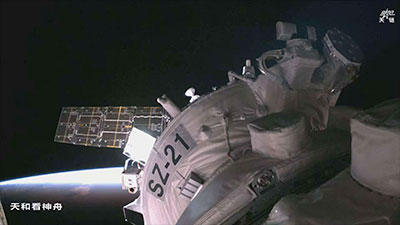China unveils Shenzhou-21 crewChinese astronauts Zhang Lu, Wu Fei and Zhang Hongzhang will carry out the Shenzhou-21 crewed spaceflight mission, and Zhang Lu will be the commander, the China Manned Space Agency announced at a press conference on Thursday (Oct. 30).
The Shenzhou-21 crewed spaceship is scheduled to be launched at 11:44 p.m. Friday (Beijing Time) from the Jiuquan Satellite Launch Center in northwest China, said Zhang Jingbo, spokesperson of the agency.
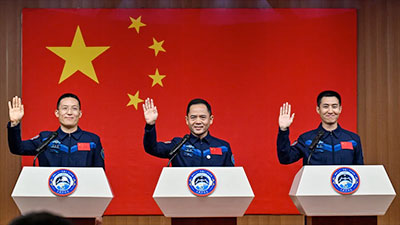
Above: Chinese astronauts Zhang Lu (at center), Wu Fei (right) and Zhang Hongzhang for the upcoming Shenzhou-21 spaceflight mission, meet the press in Jiuquan Satellite Launch Center in northwest China on Oct. 30, 2025.
The three astronauts are a space pilot, a flight engineer, and a payload specialist, respectively, representing the three types of Chinese astronauts in service, he added.
Zhang Lu was a crew member of the Shenzhou-15 mission. Wu Fei and Zhang Hongzhang, both from the third batch of Chinese astronauts, will carry out the spaceflight mission for the first time.
Before being selected as an astronaut, Wu Fei was an engineer at the China Academy of Space Technology under the China Aerospace Science and Technology Corporation, and Zhang Hongzhang was a researcher at the Dalian Institute of Chemical Physics under the Chinese Academy of Sciences.
It has been two years since Zhang Lu last went into space. He told the press on Thursday that his heart is now "filled with excitement and anticipation." He has readjusted to the high-intensity training since the end of the Shenzhou-15 mission, engaging in extensive learning and research focused on the new characteristics of the space station mission.
Zhang Lu revealed that during their six-month stay in orbit, the crew is going to celebrate the Spring Festival in a more surprising and interactive way.
"I hope to use a brand-new method to integrate traditional Chinese culture with aerospace technology," he said, hoping their festival greetings will display the romantic side of Chinese astronauts, aside from their meticulousness.
Wu Fei is the youngest among the Shenzhou-21 crew. As a spaceflight engineer, his responsibilities include looking after the space station, managing its daily affairs, and handling equipment maintenance, repair and upgrades.
"I believe in the saying 'the harder you work, the luckier you get.' Integrating my dream into the country's great space endeavor is the best luck bestowed upon me by the times," he said.
Zhang Hongzhang, a payload specialist, will be in charge of sci-tech application research tasks, involving aerospace medicine, space life science, space material science, space microgravity physics, space new technology and application, and other fields.
He will conduct experimental procedures, perform observations, acquire data, and carry out data processing and analysis.
He has long been engaged in the research on new energy and new materials. Additionally, he will be able to work on his own research project during the mission. "It is a long-cherished dream of every payload specialist to bring self-designed experiments to the space station," he said.
There will be 27 new science and application projects for the new crew to do in the space station, covering space life sciences and biotechnology, space medicine, space material science, microgravity fluid physics and combustion, and new space technologies.
The mission also planned in-orbit studies on lithium-ion batteries for space applications, and intelligent computing platforms.
The mission is the sixth manned flight mission since the space station entered the application and development phase, and the 37th flight of China's manned spaceflight program.
The Shenzhou-21 astronauts will complete in-orbit rotation with the Shenzhou-20 crew. They will also perform extravehicular activities (EVAs) and cargo handling, install space debris protection devices, deploy and recover extravehicular payloads and equipment.
They will participate in science education and public welfare activities as well.
During their stay in orbit, the Shenzhou-21 crew will welcome the Tianzhou-10 cargo spacecraft and the Shenzhou-22 crewed spaceship.
The Shenzhou-20 crew has been in orbit for 188 days and is expected to set a new record for the longest stay in orbit by a Chinese astronaut crew. During the period, the crew fulfilled a total of four EVAs and seven payload entry and exit tasks.
The Shenzhou-20 crew will return to the Dongfeng landing site in north China's Inner Mongolia Autonomous Region after completing the in-orbit handover with the Shenzhou-21 crew, the spokesperson added.











